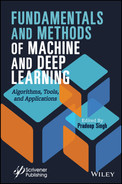Preface
Over the past two decades, the field of machine learning and its subfield deep learning have played a main role in software applications development. Also, in recent research studies, they are regarded as one of the disruptive technologies that will transform our future life, business and the global economy. The recent explosion of digital data in a wide variety of domains, including science, engineering, internet of things, biomedical, healthcare and many business sectors, has declared the era of big data, which cannot be analyzed by classical statistics but by the more modern, robust machine learning and deep learning techniques. Since machine learning learns from data rather than by programming hard-coded decision rules, an attempt is being made to use machine learning to make computers that are able to solve problems like human experts in the field.
The goal of this book is to present a practical approach by explaining the concepts of machine learning and deep learning algorithms with applications. Supervised machine learning algorithms, ensemble machine learning algorithms, feature selection, deep learning techniques, and their applications are discussed. Also included in the eighteen chapters is unique information which provides a clear understanding of concepts by using algorithms and case studies illustrated with applications of machine learning and deep learning in different domains, including disease prediction, software defect prediction, online television analysis, medical image processing, etc. Each of the chapters briefly described below provides both a chosen approach and its implementation.
Chapter 1 assists in learning supervised machine learning algorithms and their applications.
Chapter 2 discusses the detection of zonotic diseases using ensemble machine learning algorithms.
Chapter 3 provides machine learning model evaluation techniques.
Chapter 4 analyzes MSEIR and LSTM models for the prediction of COVID-19 using RMSLE.
Chapter 5 discusses the significance of feature selection techniques in machine learning.
Chapter 6 provides insight into the development of disease prediction systems using machine learning and deep learning.
Chapter 7 discusses the detection of diabetic retinopathy using ensemble learning techniques.
Chapter 8 presents a case study for medical analysis of heart disease using machine learning and deep learning.
Chapter 9 discusses a novel convolutional neural network model to predict software defects.
Chapter 10 familiarizes the reader with the process of predictive analysis on online television videos using machine learning algorithms.
Chapter 11 discusses a combinational deep learning approach to visually evoked EEG-based image classification.
Chapter 12 gives a comparative analysis of machine learning algorithms with balancing techniques for credit card fraud detection.
Chapter 13 describes crack detection in civil structures using deep learning.
Chapter 14 discusses measuring urban sprawl using machine learning.
Chapter 15 is all about the applications of deep learning algorithms in medical image processing.
Chapter 16 assists in understanding the simulation of self-driving cars based on deep learning.
Chapter 17 discusses assistive technologies for visual hearing and speech impairments using machine learning and deep learning solutions.
Chapter 18 provides insight into the role of deep learning in remote sensing.
Finally, I would like to express my heartfelt thanks to all authors, reviewers, and the team at Scrivener Publishing for their kind co-operation extended during the various stages of processing this book.
Pradeep Singh
November 2021
